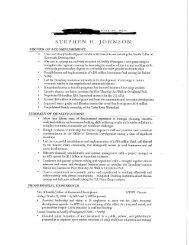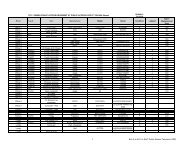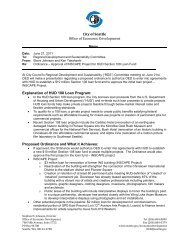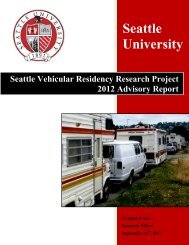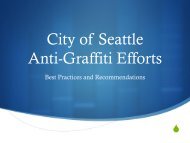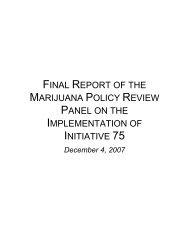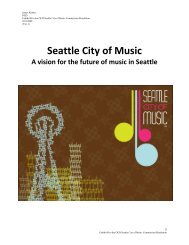2013 Water System Plan, Volume II - Seattle City Clerk's Office - City ...
2013 Water System Plan, Volume II - Seattle City Clerk's Office - City ...
2013 Water System Plan, Volume II - Seattle City Clerk's Office - City ...
You also want an ePaper? Increase the reach of your titles
YUMPU automatically turns print PDFs into web optimized ePapers that Google loves.
Fecal coliform samples are also collected at this location once per day for a minimum of 19 days<br />
a month.<br />
Treated <strong>Water</strong> Monitoring – Treated water monitoring consists of monitoring to determine<br />
inactivation of Giardia, Cryptosporidium, and viruses. This monitoring is conducted<br />
continuously for the ozonation system, UV treatment, and chlorination. For ozone inactivation<br />
of Giardia and viruses, monitoring includes temperature, initial ozone concentration, ozone<br />
decay, and flow rate. For inactivation of Giardia and Cryptosporidium with UV, monitoring<br />
consists of flow rate through each reactor, UV transmittance, UV dose, lamp power, and lamp<br />
hours. For inactivation of viruses with chlorine, monitoring includes flow rate, clearwell<br />
volume, pH, chlorine residual, and temperature.<br />
Finished water entering the system is continuously monitored for chlorine residual, temperature<br />
and pH. Daily samples are also analyzed for coliform, although this is not required by<br />
regulation. Additional monitoring is required to meet the Service Agreement with the DBO<br />
contractor. Service Agreement monitoring is summarized in Table 3.<br />
Distribution <strong>System</strong> Monitoring – Residual disinfectant concentration is measured at the same<br />
time and location that a routine or repeat coliform sample is collected within the distribution<br />
system.<br />
Disinfectants/Disinfection By-Products Rules (40 CFR 141.130-135, 141, 142) and<br />
WAC 246-290-300 (6)<br />
Current regulations (Stage 1) require trihalomethane (THMs) and haloacetic acids (HAAs)<br />
monitoring in the distribution system. SPU is required to collect two samples each quarter at<br />
existing sample stands within the direct service area under an approved reduced monitoring<br />
schedule. One of these stands is generally served by Cedar water and one is generally served by<br />
Tolt water. These two samples are collected at sample stands that are considered to represent the<br />
maximum residence time in the system for each source. Currently, sample stands G2 and B4 are<br />
considered to represent the maximum residence time for the Cedar and Tolt, respectively. SPU<br />
elects to collect two additional THM and HAA samples each quarter for informational purposes.<br />
The other two sites used are J-3 and A-3. These are considered average residence time and<br />
generally represent higher HAA levels.<br />
Monitoring for chlorine residual currently conducted at total coliform sample sites in the direct<br />
service area are reported under the Stage 1 rule. Bromate and bromide monitoring are conducted<br />
for the Tolt and Cedar supplies now that ozonation facilities for each supply are in operation.<br />
The monitoring for bromate is conducted monthly at the entry to the distribution system. The<br />
bromide monitoring was conducted monthly for the source water prior to any treatment during<br />
the first year of operation of the Tolt and Cedar <strong>Water</strong> Treatment Facilities.<br />
Stage 2 DBP Rule was finalized in January 2006. This new rule will require increased<br />
monitoring for DBPs. Following the completion of the Initial Distribution <strong>System</strong> Evaluation in<br />
2008, twelve sites were selected based on the criteria in the Stage 2 rule. Stage 2 DBP<br />
monitoring will begin at these 12 sites in the second quarter of 2012. Compliance under the<br />
Comprehensive <strong>Water</strong> Quality Monitoring <strong>Plan</strong> Page 4 of 12



